The only way is UP, baby, for you and me now…
So sang Yaz and the Plastic Population back in the 80s, and it’s what we are going to be singing now as well. Put your dancing shoes on and smash out the House music classics. There’s no doubt that the densities of our cities are going to be intensified, but we are left to discuss is – just how much, and also – what control do we have over this?
As we all now know, both Labour and National did an almost unthinkable thing recently – agreeing with each other – in the RMA Enabling Housing Supply (and Other Matters) Amendment Bill. This proposes to allow buildings in Tier 1 cities (that includes Wellington, in case there is any doubt) to allow up to 3 dwellings of at least 3 storeys high on every Residential site, up to 11m high (and arguably 12m high including the roof), all without having to ask anyone for Resource Consent permission. You’ll still need to obtain Building Consent of course, but BC doesn’t deal with issues like Design, Appearance, closeness to Neighbours, sunlight access, heritage, etc. Yes, sunlight access – like the rules changing from an imaginary line 2.5m up at the boundary and then in at an angle of, say, 45º – that will now become a line 6m up at the boundary and then in at an angle of 60º which really does mean that there is absolutely no reason not be be going up very quickly. If you go over 50% site coverage then you will still need permission.
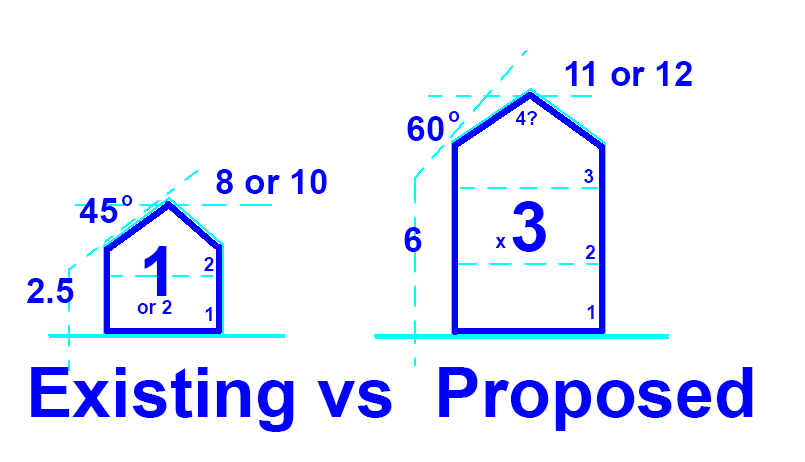
This is seen as a sop to those squeaky wheels who have been loudly crying out that “city character is about people, not buildings” and that “we need more affordable housing in our cities“. Both of those are admirable sentiments that both Tamatha Paul and I agree with – but its on the “How do we do that” that we might disagree. Councillors Paul, Matthews and Day all seem to be under the impression that old buildings are cold, draughty, and inhospitable, as well as containing racist colonial overtones. They also seem to believe that all new buildings will be acceptable because they will be warmer and less colonial, as well as somehow magically being more affordable. There are so many faults in their logic – primary amongst them being that a new multi-storey building constructed to the modern Building Code will be automatically affordable to those on the breadline – sadly nothing is further from the truth. Post-script: actually, I really don’t agree with the first statement – its both architecture AND people that make a city, and neither would exist without the other. We need good character buildings, old and new, and we need good character people in them, old and new.
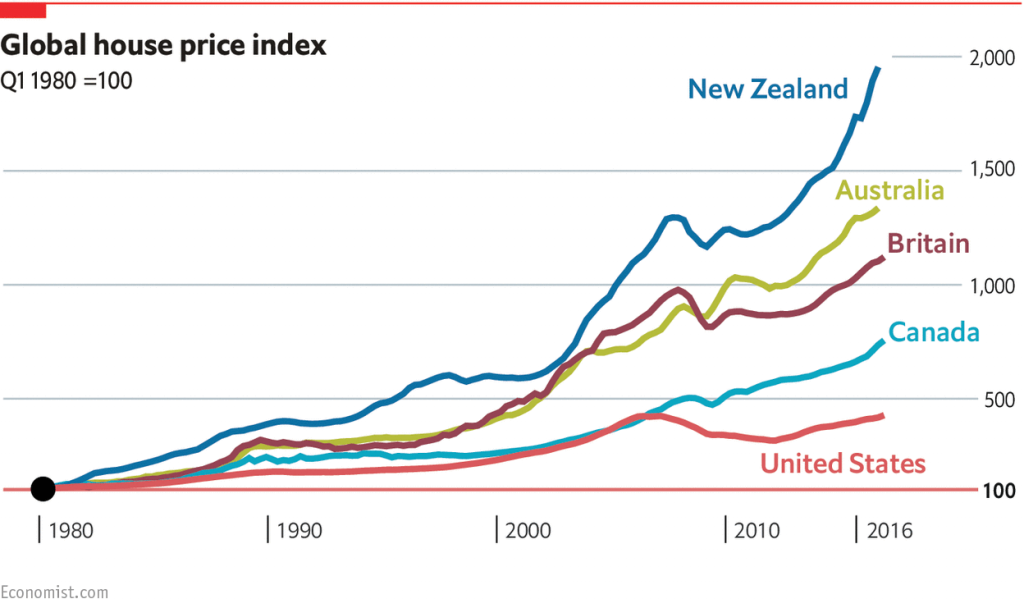
There was an advert in the Saturday DomPost, which has been posted by Felicity Wong of the Wellington’s Character Charitable Trust, opposing the removal of the Right of Appeal, and I’m also pretty sure, lamenting the potential loss of hundreds of nice old buildings. This is a valiant attempt, but also quite extraordinary – it costs hundreds, or maybe even thousands, to place an advert in the national newspaper, and so for an individual or a small charity to place this advert shows that there is some desperation about what the Government are proposing. There is no doubt that many people are quite rattled. The original article is here. If you are interested, submit on the RMA bill before Midnight on Tuesday 16 November – just TWO days away – go to www.parliament.nz and make a submission, saying that you oppose clause 14’s removal of the Environment Court mandate.
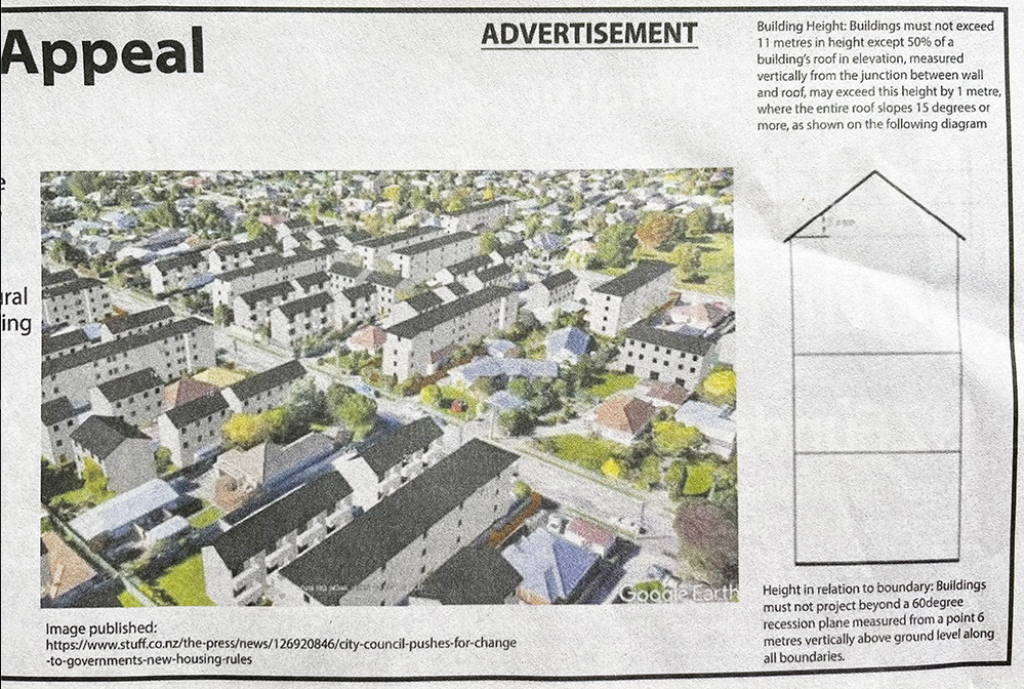
So, the Eye of the Fish is searching for ways to illustrate what is likely to / about to happen. Unlike the picture used in Felicity Wong’s illustration, which gives the impression that we are staring down the barrel of a loaded gun that is about to go off in our faces, sites and buildings are not likely to all be redeveloped at the same time. It’s far more likely to be a lot more piecemeal, bit by bit, so you are not really quite aware it is all going on until it has already happened. So, are there any examples of where that has already happened?
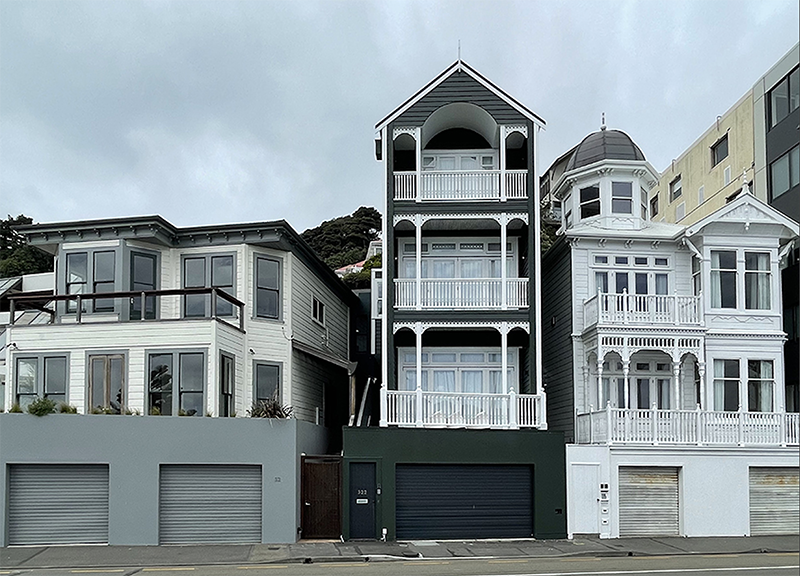
Well, yes there are some. Oriental Parade, pictured above, enjoys not only the best position in Wellington (facing north, fronting onto a beach, incapable of being built out), but also has some quirks of bureaucracy – over the years they have some fairly stiff height limits imposed, but along with 100 % site coverage they seem to be enjoying their expensive properties to the max. I’m fairly sure that the two properties depicted in the pic above have been added to either with the garage below, or via a new rooftop addition up above. Either way, its not the end of the world.
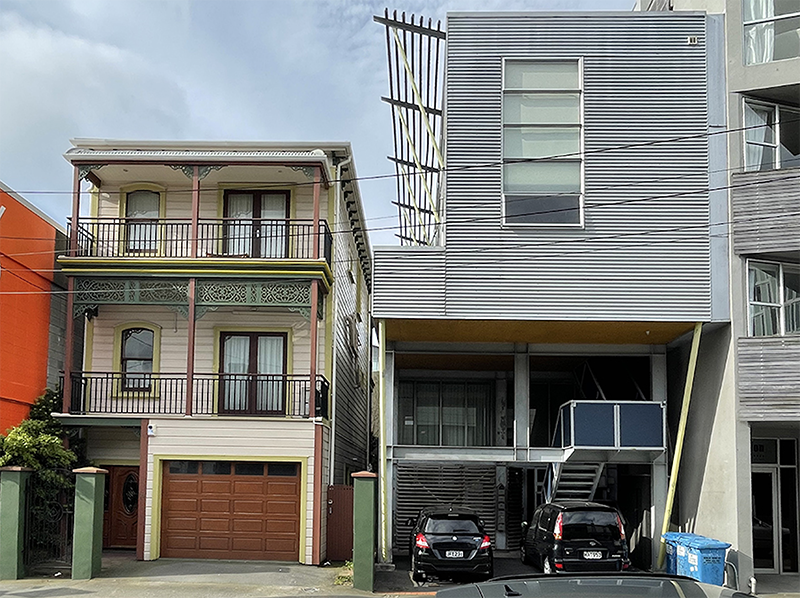
There’s also an example in Jessie Street, where an existing two-storey house was raised up and a new floor inserted underneath. Because this is Te Aro, and not a Residential zone, you’re allowed to go to 100% site coverage – remember in Residential zones you will only be permitted to go to 50% site coverage. What we desperately want to avoid though, is for any more buildings like the one very nearby on Jessie St, voted the worst flat in Wellington last year by the poor buggers that have to live in it (I think it is the lowest of the 3 flats visible below – the one with bars over the window).
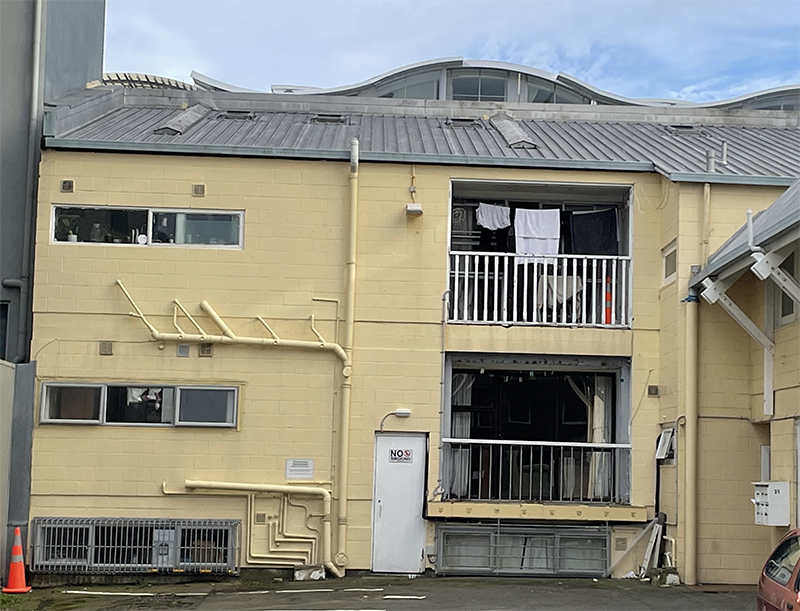
So what we need is a more accurate depiction of the likely state of Wellington after this proposal has gone through. Is Felicity Wong and the Christchurch Press right and will we look like a gulag camp for political prisoners, or are there means of doing this sensibly and politely, or will we just see a clusterfuck of bad buildings arise, festering on every block, taller, shadier, not really affordable, without parking, perhaps with zero amenities, and ruining everyone’s lives? Do we really have to destroy the village in order to save it?




On affordability: if there is enough extra supply to meet demand for housing, prices will stabilise or drop. Even if all the new places are fancy-pants and expensive — because people who can afford them and move in must free up a less desirable place somewhere else.. That’s the best argument for densification aiding affordability. Not that new dwellings will be cheaper in the market, but overall supply will meet demand faster. Now whether these rules will make a meaningful difference to the number of dwellings is a good question, since I suppose there are other constraints on building like the labour supply in these pandemic times, capacity of services/infrastructure, etc. But we must start somewhere.
Absolutely right Stephen, but the problem is we have a very large amount of Supply to catch up on. How many new houses over and above the normal amount have been provided so far this year? The price is unlikely to drop until there’s actually a surplus – and that’s not going to be some time yet….
As an architect with a site that I’m looking to develop in the next year this change excites me as it will allow me to appropriately develop with consideration to privacy, amenity, neighbourhood, urban design, etc. for the specific site without needing to stick within the broad-brush requirements of the current plan which are not appropriate. And without the need to battle with particular Council officers or neighbours who see only outcomes within their 1800mm high boundary fence.
However, as an architect with an interest in the urban environment this change scares me as I know many out there will be looking to maximise with a broad-brush approach regardless of the site and its appropriateness.
No one would argue additional housing it’s not required, but it needs to be done with appropriate consideration of long-term outcomes. There are plenty of poor examples throughout Aotearoa of rushed development which are now resulting in poor urban environment. What’s needed is a middle ground and a level of control, which to credit WCC was largely what the draft district plan is…
KayCee – I’d argue that as an architect, you’re likely to have a good sense of design and so the world should not be afraid of what you are going to do to your site. But I can’t say that I would feel quite so mellow about many members of the public who may have the land, and the will and the way, but who may stumble on the way to a good design outcome. As you say, “appropriate consideration of long-term outcomes.” We need architects to be involved – certainly not just left up to builders, as these things so often are…
This is a really interesting discussion – thank you. I don’t know if the ‘village has to be destroyed’ to make improvements. But if we want a country that has some sense of community and street life as being normal (sorry not the National Radio idea that somehow a community exists because there is a primary school located in a dull suburb), then I would just look at the life lived in much of South East Asia and continental Europe. To me, there are great examples of towns with a smaller population than Wellington metro, that are really much nicer to be in, live in, and have constant social contact between people. I am sure this blog’s readers will know of Spanish examples like Tarragona, Cordoba, Granada, Vilanova/Sitges and numerous German small/medium size cities. From living in, and visiting these places, clearly the town planning, and good densification is crucial, but it is so much more than that. The values and behaviours of residents in the continental European cities seems miles away from current New Zealand life. Partly, people are sitting out and eating and drinking on the streets in continental Europe through summer and winter, because this is a normal and affordable activity for most people, unlike the expensive ‘cool city’ areas promoted in Welly or Auckland (Cuba St, Kingsland etc.). Secondly, there’s a juvenile attitude to drinking in New Zealand, where it is still common to see young men stumble out of a liquor store with a box of beers, and then whether its 1981 or 2021 we have the same old stories of violent drunken behaviour in our nightlife areas – seemingly designed for kids. And thirdly, maybe just getting colour into our cities might make our grim-faced citizens feel a bit happier – the shroud of black clothes and grey houses at present is more like a gulag for political prisoners – particularly in Felicity Wong’s Christchurch.
Tina Tso – you’re right, of course, about Europe and Asia – there are great examples of street life, which I hope we get back to seeing again one day. I think that for the most part, Wellingtonians would be quite happy to eat and drink outside a lot more than now, and I’m sure that they will do, once the footpaths get widened and the traffic gets lessened – and most crucially of all, once the wind has been tamed !
Not that we will ever stop the wind from blowing of course, but more that the street environment needs to be modified at ground level with trees, with verandahs, with projecting wind-breaks, etc – we need to work harder to get there, to where we want to be.
Indeed. Work on the street, the actual commons. Personally I liked the Coalition for More Homes submission, which would push the MDRS into a form that would over time deliver perimeter blocks In NZ.
Conor, have you got a source for that – I’d like to check out what they say, thanks.
You’re not quoting the councillors cause none of them have ever said new profit led development would be affordable to those living on the bread line.
None of your chosen images are enabled by the MDRS.
Felicity Wongs image chosen to illustrate the MDRS is simply wrong as each site has either more than 3 hones or no side setbacks
Finally, Wellington’s inner suburbs already have site coverage approaching 50% on many sections, it’s not likely to be viable to add additional dwellings on most sites in these suburbs.
I’m almost certain you are aware of all of this.
Sorry Conor, but you’re wrong on several of those points. I sat through several hours of an interminably long Council meeting, and there were three or four Councillors who repeatedly stated that they were trying to get affordable housing through demolition of old single houses, which Councillors Matthews and Paul both classify as “colonial”.
Our practice has already had a few enquiries from clients over whether there is room for an extra house or two onto their existing land. Far from being at the limit of 50% coverage at present, there are many sites which hover around the 30-35% site coverage at present, and with some very careful clever design, another house at 15-20% site coverage could be added in. There’s also the option of gaining extra housing units on site by simply raising the existing house up, adding in a new floor below, and creating a new house that way, with little or no extra site coverage being utilised. I wasn’t actually trying to portray images as solely being enabled by the MDRS, but instead illustrate the practice of raising buildings up.
In other areas such as the Upper Hutt, current site coverage rules decree a 30% max coverage, and sections up there are larger and flatter. I wouldn’t be surprised if there is a boom in backyard building up the Hutt Valley.
I agree that the image Wong has chosen is probably more scare-mongering than actually likely – but it does raise the question then, of what exactly is possible?
Yep basically everyone agees that building more homes is more likely to make homes more affordable. But I doubt anyone has said private developers will directly deliver homes affordable for those who can only just afford bread. It’s second order effects where there’s less pressure on rentals, then less pressure on social homes.
Nemo – do we have any stats on inner residential average site coverage? Isn’t 45% allowed in the current DP anyway?
In terms of what’s possible, the MDRS will have the biggest effect in the North part of WCC. And as you say significantly more effect in the Hutt Valley, and also Kapiti. Homes.co.nz reckons Christchurch and Hamilton will see the most change due to having large flat sections. Change for inner suburbs will be large, but that’s due to the NPS-UD, which has already been breathlessly litigated. In fact, I seem to recall an entire post on here that used a 200sqm Mt vic site in it’s scenario. Are your client enquiries largely from inner suburban Wellingtonians?
Clients from all round NZ in general, but yes, the cases I mentioned are all from Wellington. The 200m2 site I mentioned on Mt Vic in a recent post was entirely hypothetical though, just for me to test some numbers on.
Here’s the coalition for more homes: https://drive.google.com/file/d/11g2HxpZj_toNuSjLurhNXbiX6x92JQZL/view
Thanks Conor, hugely useful. They’re absolutely on the right track.
And a thread on Twitter from the same https://mobile.twitter.com/morehomesnz/status/1458923229922279449